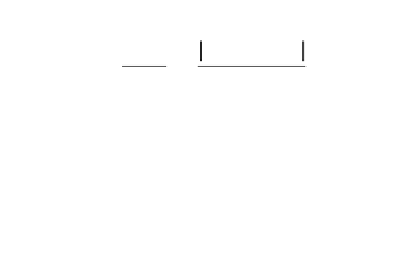Graphics Reference
In-Depth Information
w
=
0
,
w
=
1
1
,
0
k
n
pp
-
Â
ij
,
ij
,
-
1
ww
=
+
,
0
<<
j
k
j
j
-
1
n
+
1
L
i
i
=
0
where L
i
is the chord length of the polygonal curve with vertices
p
i,0
,
p
i,1
,...,
p
i,k
, and
v
== =
...
v
0
,
v
==
...
v
=
1
,
0
e
k
+
1
k
+
e
+
1
se
+-
Â
1
1
v
=
ws
,
=
1
,...,
ke
-
.
se
+
i
e
is
=
There are problems with this approach.
(1) The surface may not have the desired shape.
(2) There may be lots of knots {u
i
} with some very close together causing potential
numeric problems in applications that may use this data.
(3) The surface may have self-intersections.
Part of the problems is caused by the fact that we had to choose the
same
knot vector
for all the curves in the v-direction. In order to overcome some of these problems
[FilB89] describes a skinning surface in a procedural way. This new method also does
not require the curves to be B-splines. The steps to compute the parameterization
p(u,v) at (u,v) are outlined in Algorithm 14.7.2. In practice, a cubic approximation to
the function v
i
(u) simplified the computations and was found to be adequate.
Finally, we point out that skinning is really a special case of the more general
surface reconstruction problem. We are given a set of scattered data points and want
to fit a surface to those points. There is no time to go into this topic here, but we leave
the reader with sample references for this and a related problem. In [BoiC00] the
reconstructed surface is an implicitly defined smooth manifold. The paper [ACDL00]
simplifies a previous algorithm and also proves that if the data came from a surface,
then the construction is homeomorphic to the input surface. In [HuaM02] there is an
algorithm for creating a combinatorial manifold mesh given some unorganized point
samples from an existing object. A related two-dimensional problem is image recon-
struction that involves fitting a continuous intensity surface through image samples
and [YuMS01] describes an approach that does not depend on patch boundaries lining
up with coordinate axes. These papers contain many additional references.
14.8
Computing Arc Length
Let
[
]
Æ
R
3
pab
:,
(14.21)
be a parametric curve. This section discusses algorithms that solve the following two
problems:



